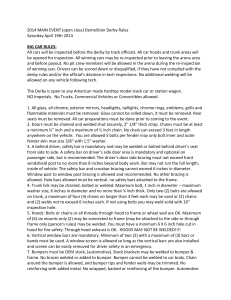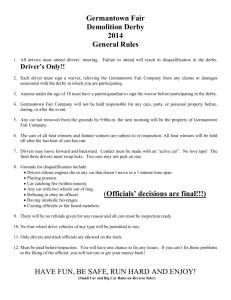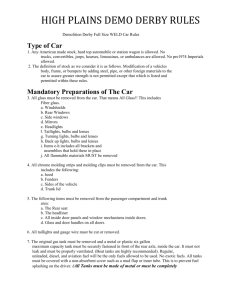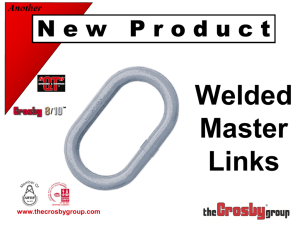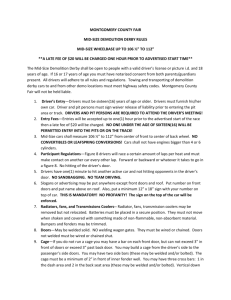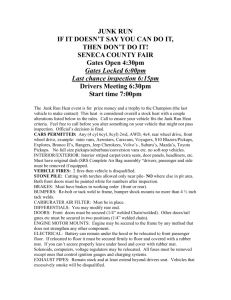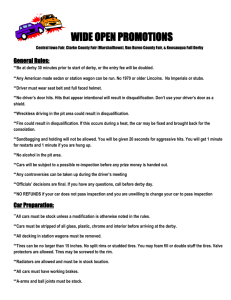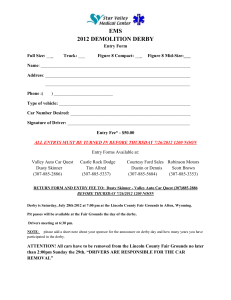2015 Demolition Derby Rules
advertisement
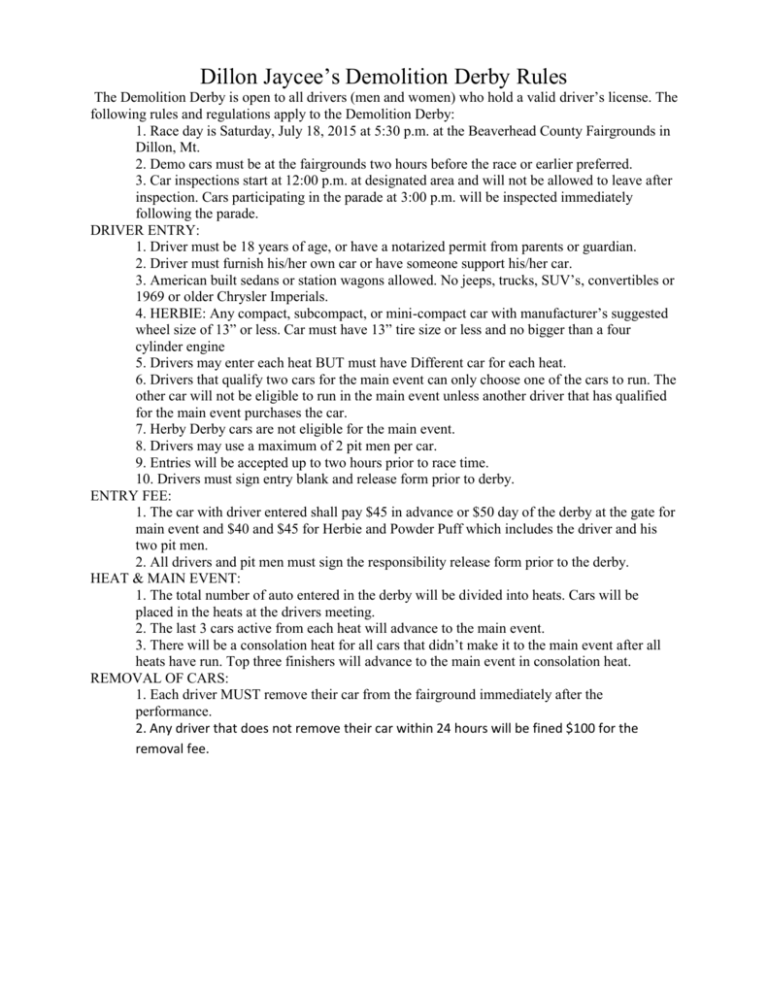
Dillon Jaycee’s Demolition Derby Rules The Demolition Derby is open to all drivers (men and women) who hold a valid driver’s license. The following rules and regulations apply to the Demolition Derby: 1. Race day is Saturday, July 18, 2015 at 5:30 p.m. at the Beaverhead County Fairgrounds in Dillon, Mt. 2. Demo cars must be at the fairgrounds two hours before the race or earlier preferred. 3. Car inspections start at 12:00 p.m. at designated area and will not be allowed to leave after inspection. Cars participating in the parade at 3:00 p.m. will be inspected immediately following the parade. DRIVER ENTRY: 1. Driver must be 18 years of age, or have a notarized permit from parents or guardian. 2. Driver must furnish his/her own car or have someone support his/her car. 3. American built sedans or station wagons allowed. No jeeps, trucks, SUV’s, convertibles or 1969 or older Chrysler Imperials. 4. HERBIE: Any compact, subcompact, or mini-compact car with manufacturer’s suggested wheel size of 13” or less. Car must have 13” tire size or less and no bigger than a four cylinder engine 5. Drivers may enter each heat BUT must have Different car for each heat. 6. Drivers that qualify two cars for the main event can only choose one of the cars to run. The other car will not be eligible to run in the main event unless another driver that has qualified for the main event purchases the car. 7. Herby Derby cars are not eligible for the main event. 8. Drivers may use a maximum of 2 pit men per car. 9. Entries will be accepted up to two hours prior to race time. 10. Drivers must sign entry blank and release form prior to derby. ENTRY FEE: 1. The car with driver entered shall pay $45 in advance or $50 day of the derby at the gate for main event and $40 and $45 for Herbie and Powder Puff which includes the driver and his two pit men. 2. All drivers and pit men must sign the responsibility release form prior to the derby. HEAT & MAIN EVENT: 1. The total number of auto entered in the derby will be divided into heats. Cars will be placed in the heats at the drivers meeting. 2. The last 3 cars active from each heat will advance to the main event. 3. There will be a consolation heat for all cars that didn’t make it to the main event after all heats have run. Top three finishers will advance to the main event in consolation heat. REMOVAL OF CARS: 1. Each driver MUST remove their car from the fairground immediately after the performance. 2. Any driver that does not remove their car within 24 hours will be fined $100 for the removal fee. 1- Any year O.E.M. frame and body model of passenger car or station wagon except for the following: 2- 1969 or older Chrysler Imperials. No Jeeps, trucks, SUV’s, convertibles. 3- We reserve the right to and re-inspect cars at any time before, during or after the event, even after it has been flagged. You may be asked to cut areas of question open before, during and after the derby if needed. WE ARE PRIVELIGED TO USE ALL OR OUR FACILITIES! PLEASE TAKE EXTRA CARE IN STRIPPING YOUR CAR! 4- JUDGES RULING IS FINAL. Our judges are volunteers. They have over 50 years of experience combined in judging and also running demo cars themselves. Any arguing or fighting with the judges by drivers or pitmen, etc., will not be tolerated and will be cause for disqualification. 5- NO ALCOHOL IN PIT AREA. 6- NO HITTING OPPONENT’S CAR IN DRIVERS DOOR. 7- Any car participating in the Heat, Constellation, Main Event, Powder Puff, Grudge Match or Herbie Derby goes outside the logs during the race whether the person is making the hit or being hit will be flagged out for that race. PREPARATION: 1- All glass, plastic, and pot metal must be removed. Nothing may remain in the bottom of the doors, trunks. All outside hardware must be removed (door handles, mirrors, chrome, molding, screw, fiber glass, etc). All rear seats must be removed. 2- No added weight to the car except the weld. No packing the frames, trunks, passenger doors, or under floor decking. 3- Front seats must be securely mounted to the floor, and must have seat belts. 4- All flammable materials inside the car must be removed 5- Your number must be at least 18 inches tall and must be painted on each side of your car on the doors (if you want your number reserved please call in advance) 6- ALL CARS MUST BE COMPLETE BEFORE BEING INSPECTED. Fuel Pumps: 1- Externally mounted electric fuel pumps are allowed. ON/OFF switch must be located within drivers reach inside the car. Tires: 1- Wheel size is not to exceed 15”. NO PADDLE TIRES OR STUDDED TIRES. 2- Implement tires are ok 3- No tires allowed that have a full tread running from side wall to side wall they must have a break in the tread(NO PADDLE TIRES) 1- You may use any tire (except paddle tires and studded tires) and you may tube, screw, glue, tire inside of tire, flappers, and use recaps. Only air must be used to inflate your tire. 2- You may weld valve stem protectors. 3- No wheel weights. Brakes: 1- All cars must exhibit the ability to stop before entering the arena. If a car loses its braking ability it will be subject to disqualification. Engines and DP protectors In an effort to keep this simple and fair: Distributor protectors may only be bolted to the motor If your distributor is in the rear of the car, the protector may be a max of 12” wide and no farther than 3” from the distributor cap and no more than ¼” thick If you have a front distributor, the rear support plate may only be 12” wide but may not be more than 1 inch from the block and no more than ¼” thick. DP must be a minimum of 5 inches from the dash bar, window bar or any added metal. Engine cradle must be mounted to the engine only. No other part of the cradle or DP may be mounted to the frame. Pulley protector may not e more than 2“from the front of the pulley and no more than ¼” thick and must be mounted to the engine only. IF YOU HAVE ANY QUESTIONS SEND US A PICTURE FOR APPROVAL Two additional motor ties downs may be used but must attach to the block or heads and not the engine cradle or DP protector. No more than ONE fastener on each side of the motor may be used. If straps are used they may only be welded, within reason, to 3 inches per side on the frame. That section that is welded to the frame may not be any thicker than ¼ inch thick and 2” wide, and MAY NOT extend in front or the water pump or behind the engine block any more than 4 inches. Any engine and transmission combination may be used in any car, but must be mounted within 4 inches of the original motor. Must be mounted securely. You may cut a hole in the firewall to accommodate the engine within reason. However it must be covered to prevent a fire hazard. Motor mounts may be welded; when making motor mounts to raise shift or use different motors in different cars, mounts cannot exceed original footprint of motor mount. You may cut a hole to accommodate the distributor. Distributor protectors are allowed see above. No holes will be allowed in the floor of the car except to accommodate the transmission shifter, fuel and transmission lines and wiring. Shifters may be tack welded or bolted. Patching holes is for safety not reinforcement, if patching rust holes you may use sheet metal only not to exceed 2 inches past rusted area. You may tilt your rear end by shortening or lengthening rear end control arms; however, they must remain functional. Do not reinforce more than one inch past cut or extension area, must use metal of same thickness or less, no other welding other than the cut seam is allowed. Cuts must be made in the middle of the arms, and no metal added to the inside or ends of the control arms. Rear ends: 1. Any 5 lug rear end may be used. FOR USE BELOW: 1- Note due to the price of metal we will use a “within reason” clause; however if you push it we will make you cut it! 2- Only 3/8” round hot, cold or rebar, or 2” x 3/16” flat strap may be used for seam welding. 4- #9 wires may be used in place of chain only and only 4 strands may be twisted together. Securing: 1-One or more of the following (welding, chaining or bolting) must be used to secure your hood and trunk. If the hood is welded there must be a 30”x30” hole cut in the hood for inspection. The tailgate of a station wagon will be treated as a trunk. #9 wire may only be used in place of chain were chaining is allowed. Doors and windows: 1- Doors may be fully welded. Door seams may be welded OR you may chain or use #9 wires, at least twice per seem. If chaining or wiring, none may go through the frame. 2- A protective bar must be placed inside or outside on the driver’s front door. It cannot extend more than 6” past the driver’s door seam on either side you must trim angle iron corners. NO GRADER BLADE. 3- No window openings may be snaked through quarter panels to the roof with chain, cable or wire. 4- One or two bars running from the roof down to the cowl or front dashboard bar is mandatory! No more than two bars may be used 5- DOOR seams ONLY may be pinched and welded were the windows come up through. 6- You may use a screen or netting over drivers side front window and driver’s door only. Interior bars: 1- All interior bars must be no less than 2” minimum and maximum of 4” in diameter with a minimum of 4”x4” or max of 12”x12” end plates. End plates must be welded in place no bolting allowed. 2- A bar behind the seat or the seat chained to the roof is mandatory. The bar must be located no more than 6” from the final resting position of your seat. 3- You can run an upright post or roll loop, the halo must be ATTACHED to the roof, seat bar and floor(NOT FRAME) no more than 6” behind the driver’s seat . It may be welded or bolted to the floor. This is for safety so please make sure it is welded adequately or bolted. 4- An optional bar may be put in the front where the dashboard was located, in between the front door posts. 5- You may weld a connecting bar on the inside of the driver’s and passenger door only from front bar to the rear bar creating in essence a box. 6- All bars and posts in the proximity of the head must be padded. 7- Overall safety will be determined by the official’s at time of inspection. Welding: 1- You may inner seam weld. 2- You may weld the floor pan seam under the gas and brake pedal only for safety, no filler may be used. 3- All exterior hood and trunk seams may be fully welded. The tailgate of a station wagon will be treated as a trunk. 4- In addition to the weld, you may bolt or chain through the trunk lid and floor. Bolts may go through the frame or uni-body and may replace only 1 body mount and bushing per frame rail in the trunk floor pan area or it may be welded to the side of the frame. 5- No painting or undercoating may be used underneath the car. Bolting: 1- Instead of welding your hood you may use bolts or chain to secure the hood 2- None of these bolts may go thru, around, or touch the frame or uni-body except the radiator support. Chains or #9 wire: 1- Chain is allowed to secure front and rear bumpers to the frame. It may loop thru the hood or trunk. 2- You may weld a 3” washer to the hood to run the chain thru. 3- You may use on the bumpers, in place of chain up to ¾ inch rolled steel or 2” x 3/16” wide flat strap welded from the hood or trunk no more than 6”up to the chrome of the bumper. Bumpers: The intention of this rule is to allow you to mount the bumper in such a way that it will not fall off. Upon inspection if it is determined that you have exceeded the intention of the rule you will be disqualified. 1- Stock O.E.M. bumpers of passenger cars must be used. 2- Bumpers may be cut so they do not smash into the tires during the event. Chrome may be welded to the inner bumper box to keep it from separating. 3- Bumpers may be flipped. 4- Only One bumper bracket per frame rail may be welded to the frame, and can be welded and/or bolted no more than 10 inches from the front of the frame. 5- If swapping bumper and brackets: You may only use the mounting hardware that was on the car originally or one style of car bracket hardware and a car bumper. All other hardware must be removed. (ex. Chrysler bumper with GM shock brackets on a Ford) Shock tube will be considered the bracket if disassembled from the mounting hardware. If this is done then rule #5 applies. Mounting brackets may not be attached to the Cordoba type sub or k-frame in any way. If using an Aluminum beam bumper you may weld your front straps around and to the bottom of the bumper bracket 7- Compression bumper shock tubes may be compressed and welded. 8- No material may be added other than the weld. 9- Chrome may be welded to the body on compression bumpers whether it is using the mounting hardware or not. Non-compression bumpers may weld ORIGINAL bumpers to the body. 10- No welding of any kind other than what is specified and straps (rule #4 chains or #9 wires) is allowed on the bumper. Frame: 1- If you cut the frame for pre-bending purposed, you may not weld the cut back together. 2- No Buffing, grinding or packing of frames 3- Humps may be chained with one wrap, but may not be welded to frame. Radiators & Radiator supports: 1- Only OEM style passenger car radiators may be used. Aluminum racing of the same style may also be used. Radiator hose loops may also be used. 2- Radiators FIN area only may be sleeved in a light expanded metal. I t may not be fastened to any part of the car. 3- Radiators must stay close to stock position in front of the motor. (No added water capacity). 4- Engine coolants are allowed. 5- Upper Radiator supports may be welded to the hood or may be bolted 6- Lower Radiator support body mount bushings may be removed and replaced with a max. 1” bolt diameter. Bolt may go up through the upper core support or hood to be used in #3 above. Transmission coolers: 1- Transmission coolers will be allowed and must be placed inside the cab. 2- Proper hydraulic, Metal or steel braided line must be used NO FUEL LINE. 3- Condenser must be enclosed or covered. 4- Overall safety will be determined by the official’s at time of inspection. Gas Tanks: 1- Original gas tanks must be removed from the car. 2- You must have your gas tank securely mounted inside the car with a minimum of two fasteners, in back seat area and covered. 3- A maximum size of 6.5 gallons can be used. 4- Fuel lines must run inside car. Original gas line inside frame cannot be used. 5- Overall safety will be determined by official at time of inspection. Battery: 1- It must be securely mounted inside the car in passenger area and covered 2- Battery Box cannot be made out of plastic; Seat belts or “pull” type straps may not be used. 3- Overall safety will be determined by official at time of inspection. Cut outs: 1- Cut outs over the wheel wells are legal. 2- Cutouts may be folded If cutouts are folded you may be asked to cut an inspection hole in them. 3- If your hood is welded must have a minimum of a 30” by 30” hole cut in the hood for inspection. If bolted, hood must be open during inspection. Unless the 30 by 30 cutout exists. 4- If inspection holes & fire holes are determined to be too small you will be asked to cut them larger. 5- If center cut out is bent forward to cover the radiator it may be fastened to the bumper with chain only. Trailer Hitches: 1- Trailer hitches and framework after Market or not must be removed. Suspension: 1- No pulling shocks and putting pipes in their place 5- No putting leaf springs on top of the axle. 6- You may weld coil springs to the frame or axle so they do not fall out (no filler may be used). 7- You may not clamp the shocks. No solid suspension. 8- You are allowed 9 leaf’s maximum. 9- You may use only 3 clamps total per leaf spring pack, no welding. Springs must be of passenger car origin. Clamps may be no wider than 3” using only one set of bolts per clamp. 10- Original leaf spring cars must be mounted in original mounting position. Attachment point on the frame can be no more than three inches.(ie, size of a shackle) 11- No air lift shocks, coil over shocks, blocks, shackle, or any reinforcements.
